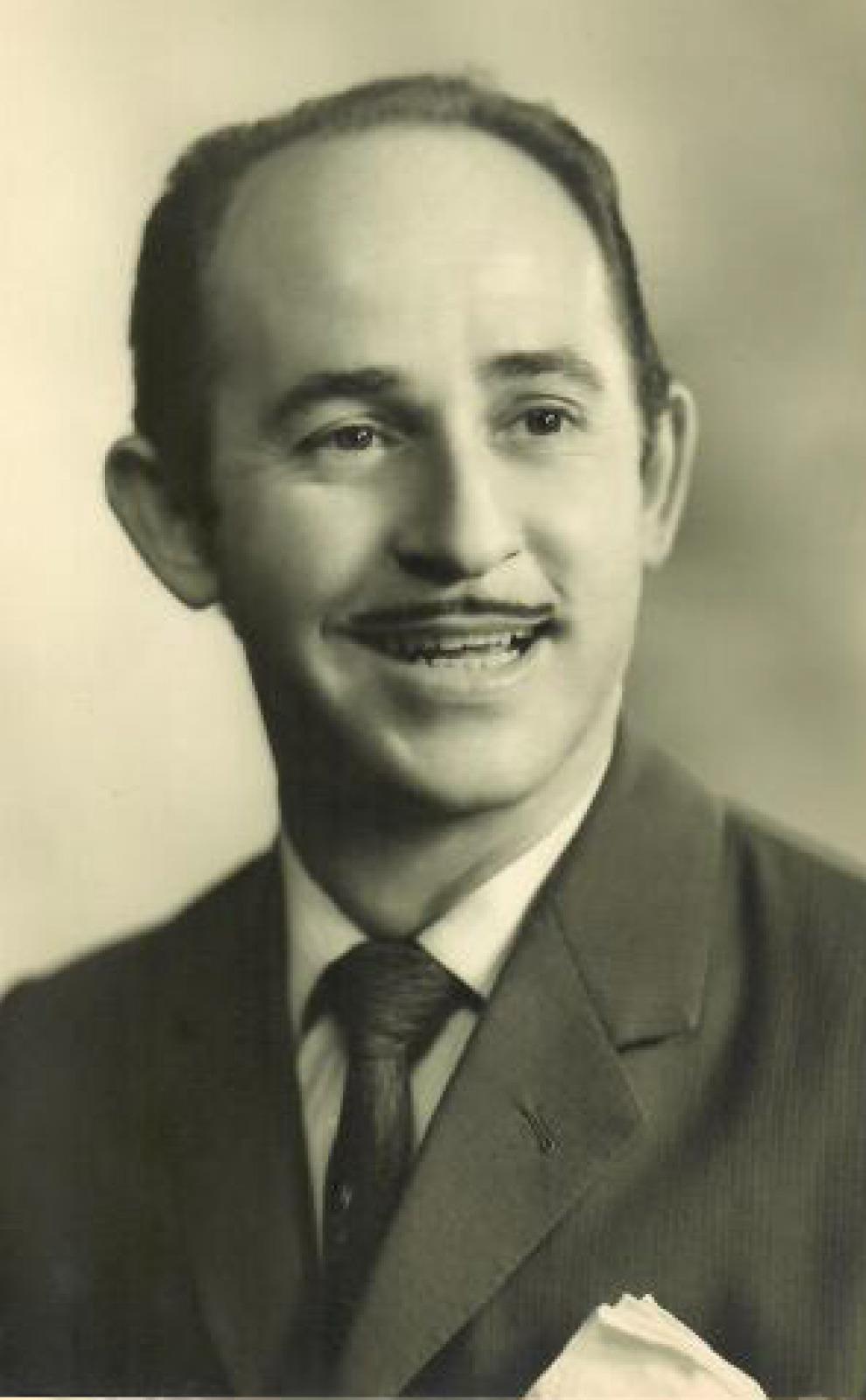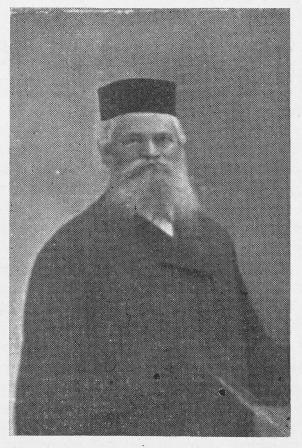Schwartz was born in Brod, Poland, on March 22, 1928 as Yehudah Leib Kirzner. He began his music studies as a child with his father, Yaakov, who was a cantor. He relocated to Argentine in 1938 with his mother Ana, his father and his twin sisters Clara and Frida. In Buenos Aires he studied at the Bordoni Conservatory and piano with Rodolfo Sciamarrella (father) and Eduardo Bonessi, two distinguished musicians from the tango scene. He carried out his first public musical performances in the modern orthodox Great Temple on Paso Street, next to another Polish-born musician who immigrated to Argentine, hazzan Pinchas Borenstein, and on the bilingual radio program La Hora Israelita (The Jewish Hour) in the Radio Porteña station.
In 1947, at the age of nineteen, he made his debut at the Teatro Soleil in the Abasto quarter, one of the four theaters that presented Yiddish musicals and vaudevilles during the Golder Era of Yiddish theatre in Buenos Aires. He appeared as actor and singer in the musical A fon vert geboyrn (A flag is born), an Yiddish adaptation of Ben Hecht’s Zionist fundraiser pageant that had just premiered on Broadway a few months earlier in 1946. He shared the stage with two Eastern-European born American luminaries of the Yiddish theater, Berta Gersten and Jacob Ben Ami, who were on tour in Buenos Aires. Léibele played the character of the meshulaḥ (the messenger). Within these Yiddish theatrical circles of Buenos Aires, he also worked alongside international artists such as Sarah Gorby, Max Perlman, Perlman’s wife Guita Galina and the renowned Polish-born comedians Dzigan and Shumakher (Shimen or Szymon Dzigan, 1905-1980 and Yisroel Shumacher or Szumacher; 1908-1961),1 at the Excelsior Theater, when the duo was on tour in Buenos Aires (c. 1951). Schwartz was also a member of the “Zimrá” Musical Ensemble under the direction of Paloma Efron (“Blackie”, Argentine’s first female jazz singer), along with notable artists such as Dina Rot, Berta Biali and others.
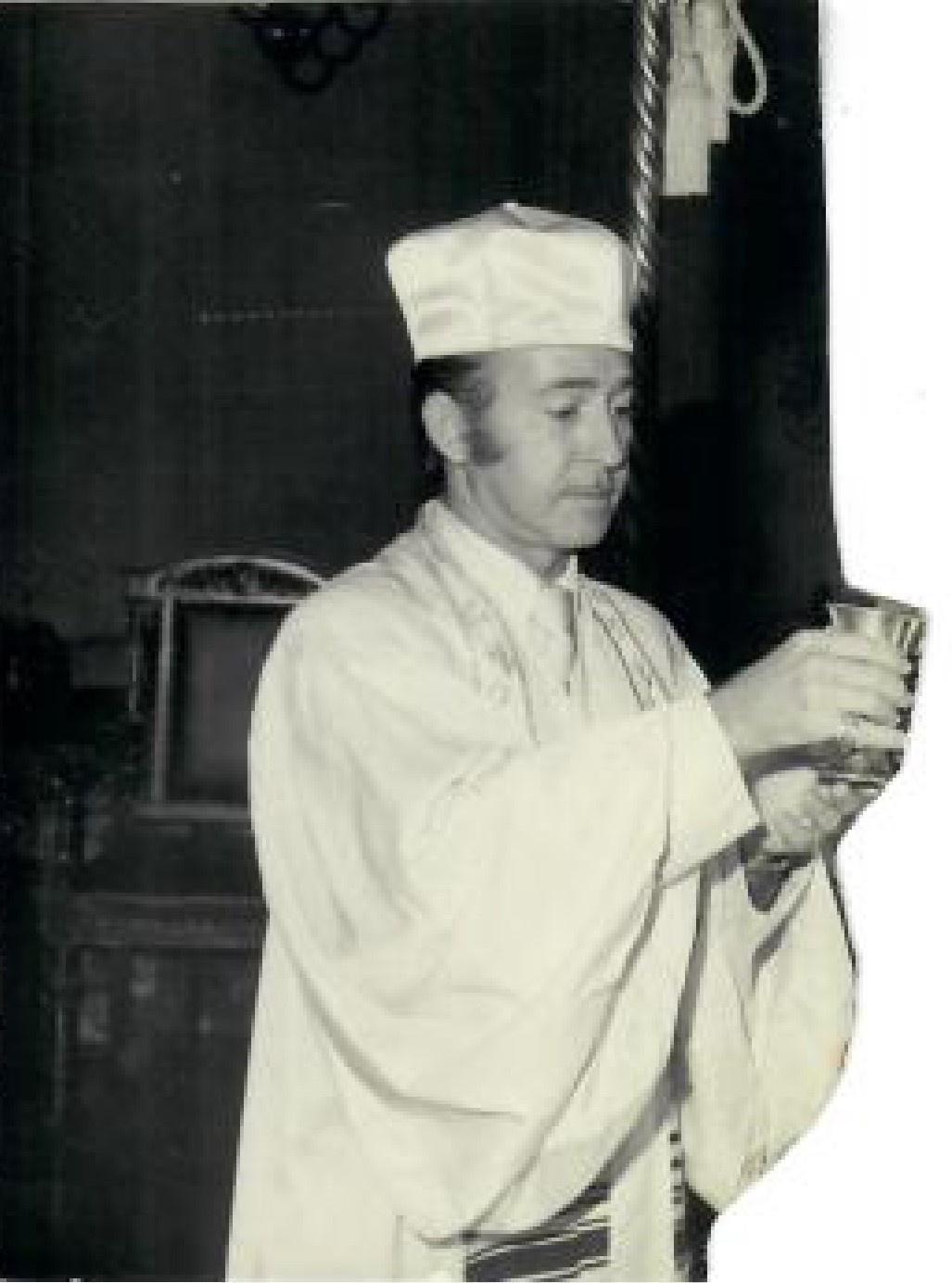
Leibele preparing the Kiddush (from the archive of Néstor Stofblat)
In 1959 Léibele and his second wife went to Johannesburg, South Africa where he performed for three years at the Standton Shul, aka Beth Hamedrash Hagadol Standton. His next destination was the United States. Clara traveled before him to New York in 1961 because Jeffrey, their first child, was about to be born. Léibele moved on the following year. Three more children were to be born in the United States to Cecilia and Léibele: Paul (1965), Adrián (1968) and Sabrina (1969).
In the USA Léibele worked as cantor at the Congregation Shaare Zedek, the third oldest synagogue in New York City and the Jewish Center of Kew Gardens Hills, one of the oldest Jewish congregations in the central Queens area of New York City. In New York he studied voice with the renowned Italian tenor Tito Schipa. He even appeared alongside Judy Garland on the Ed Sullivan Show. In August 1967 he was invited by the State of Israel to participate in a music festival.
Upon his return from New York to Argentina in 1970, Schwartz became the cantor of the Israelite Congregation of the Argentine Republic, known as Templo Libertad (because of its location on Libertad Street). Léibele worked there for many years with composer, arranger, organist and pianist Maestro Néstor (Nachman) Stofblat. Léibele and Stofblat composed new music for the Jewish liturgy at Templo Libertad. As Léibele did not write music, Néstor transcribed the melodies created by Léibele orally and made the arrangements. Among his original works are High Holyday pieces such as ‘Salahti’ (from the prayer ‘Omnam ken,’ according to the Polish liturgical tradition) and ‘Labrit habet’ (from the piyyut ‘Ki hine kahomer’), both for the eve of Yom Kippur, and ‘P’tah lanu sha’ar’ for Ne’ilah (conclusion of Yom Kippur). He also composed music for the Sabbath, such as ‘Vehu yashmi’einu’ and ‘Yismehu bemalkhutkha” for Mussaf (additional noon prayer) and ‘Sim shalom’ (for the morning service), the later one with the celebrated cantor and composer Israel Alter. In addition, Léibele was also cantor at the Polish Jews’ Brit Abraham Synagogue (known as “Shil de Antezana”, i.e. the Synagogue of Antezana Street) in the Villa Crespo neighborhood of Buenos Aires.
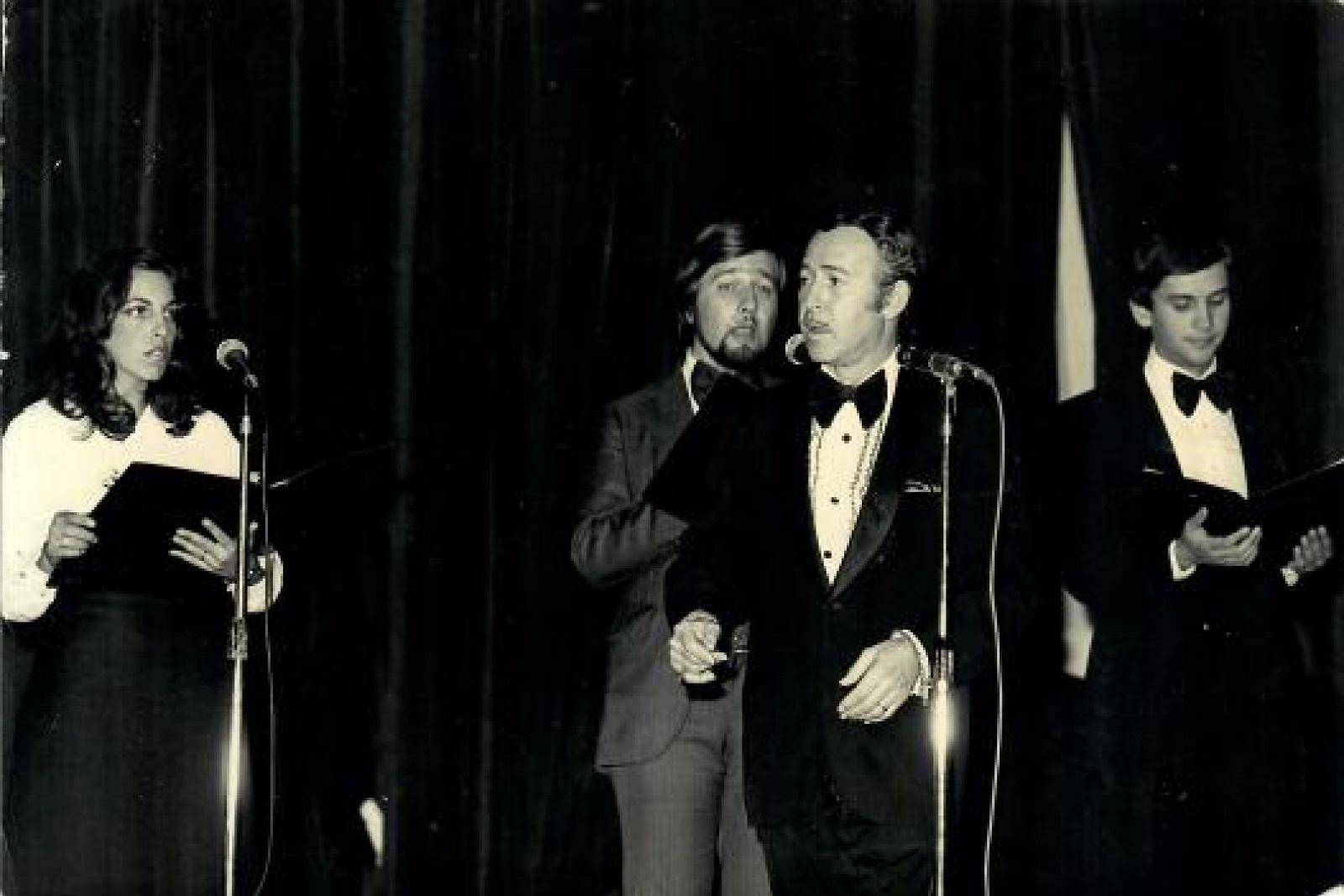
Leibele and the "Nashir Quartet" (from the archive of Néstor Stofblat)
Stofblat also directed Jewish vocal ensembles such as the Ensemble Judaica (consisting of cantors Moshe Alon, Teddy Horowitz, Abraham Smirewicz, Oshis Wichalewsky) or the Nashir Quartet (Ana Goldberg, soprano; Adrana Segal, mezzo-soprano; Héctor Notes, tenor and Abel Pérez, baritone). Léibele performed as a soloist with these ensembles on various stages in Buenos Aires and also on tours in Chile and Brazil. He also toured as a soloist throughout South America and Europe.

Leibele on the anniversary of Congregacion Israelita Paulista, San Pablo, Brazil. (from the archive of Néstor Stofblat)
Léibele was a tenor and covered a wide repertoire that included Jewish liturgical music, opera arias and works from the repertoire of the musical theatre. In his extensive career he sang as a soloist with the Philadelphia Orchestra, the Israel Philharmonic Orchestra and the National Symphony Orchestra (Argentine). Beyond these major stages he also sang in various popular venues such as the Bauen Hotel and at the Embassy Theater alongside the singer Iojebed Fij; at the Catalinas Theater in shows with actors Norman Erlich (‘Humor in G clef’) and Luis Minces; and in the musical comedy ‘Oy vey Sofía,’ at the Tabarís theater. He also worked alongside singers and actors Henry Gero, Samuel Dan and Max Berliner.
Léibele participated in fundraisers on behalf of institutions of the Jewish community in Argentine such as the Burzaco Nursing Home or the Hospital Israelita of Buenos Aires. In his popular music shows Léibele interspersed anecdotes and jokes between the songs. In the file kept by his daughter Sabrina, there is a small notebook with notes that Léibele used in his shows.
He recorded music in Hebrew, Spanish, Yiddish, Judeo-Spanish, for RCA, Radio León, Panzer and Musique Internationale (USA) singing Jewish liturgical music, Hasidic songs and songs from the Ashkenazi and Sephardic traditions (see Discography below). In 1986 he filmed a medium-length film “Léibele Schwartz sings to his roots” at the Burzaco Nursing Home and recorded several songs. The Shalosh Arba vocal quartet and the Israeli Dance Ensemble directed by Mario Goldberg also participated in this film.
Léibele Schwartz died in Buenos Aires on July 11, 1992 and was lay to rest in the Jewish cemetery of La Tablada.
___________________
1 Diego Rotman, The Yiddish Theater Stage as a Temporary Home (De Gruyter Oldenbourg, 2021); Diego Rotman, "Introduction to the Yiddish Duo Dzigan and Schumacher" on the Yiddish Book Center website.
Sources
Interviews
Clara Kirzner, sister of Léibele Schwartz (2010)
Sabrina Kirzner, daughter of Léibele Schwartz (2021)
Néstor Stofblat, collaborator and accompanist of Léibele Schwartz (2022)
Archives
Sabrina Kirzner Family Archive
Néstor Stofblat Family Archive
Matías Chapiro Family Archive
Mirtha Zuker and Horacio Liberman Family Archive
Bibliography
Glocer, Silvia 2011. Pequeños exiliados, grandes músicos. Nuestra Memoria, 17, np. 35, pp. 137-157. Buenos Aires, Fundación Museo del Holocausto de Buenos Aires.
Glocer, Silvia. 2016. Melodías del destierro. Músicos judíos exiliados en Argentina durante el nazismo (1933-1945). Buenos Aires, Gourmet Musical.
Glocer, Silvia. 202. Diccionario biográfico y bibliográfico de músicos judíos exiliados en la Argentina durante el nazismo (1933-1945). Facultad de Filosofía y Letras. Universidad de Buenos Aires, vol. 2, pp. 240-241.
Discography
Todos somos amigos. Includes: Todos somos amigos (Side A) y Mi pequeña oración (Side B). Disco Odeón N° 107, Buenos Aires, November 1956.
Todos somos amigos. LP., 1962. Includes eight songs.
El estilo personal de Liebele Schwartz. LP. Longdisc, 1976. Includes eleven songs.
Léibele Schwartz. Su voz y sus canciones. Includes Yiddish songs and cantorial music. Accompanied by Néstor Stofblat. Edited by SHIRIM.
CANTOR LÉIBELE SCHWARTZ Sings Cantorial & Chassidics melodies. LP. I. Ushis Kirshblum (narrator), Jack Baras (arrangments, piano and organ accompaniment). Produced by Barry Serota. Musique Internationale M7302. Includes: Sim Sholom, from Sabbath Morning Amida (Alter, I., Schwartz, L.); Vlyrusholoyim Ircho, from Weekday Amidah (Alter, I., Ganchoff, M.); Bei Ano Rocheits, from Sabbath Torah Service (Alter, I.); Yismechu, from Sabbath Mussaf Service (Talmud, Y.); Hamavdil, from conclusion of the Sabbath (Posner, M.); Chassdei Hashem, from Book of Lamentations (Eicho), chapter 3, verse 22 (Alter, I.); B'nei Veischo, from Festivals Mussaf Service (Fuchs, I.)
Cantorial and Chassidic Melodies. Léibele Schwartz. Musique Internationale, 1984?
Éxitos de Léibele Schwartz. LP. Accompanied by orchestra conducted by Benjamin Yankelevich. Buenos Aires, Panzer Records.
Léibele Schwartz. Pesaj - Rosh Hashaná - Iom Kipur. Organ accompaniment: Jacob Sclar. Includes: Brojo D´haleil; Isroel betj adonoy; Schuvi nafschi; Ono adonoi ki ani avdejo; Ma nischtano; Jad gadio; Daieinu; B´tzeis Isroel; Habein Iakir li Efraim; Ki keischimjo; V´al iedei avodejo; Ovinu malkeinu; Ato iodeia rozei oilom; Haiom haras oilom
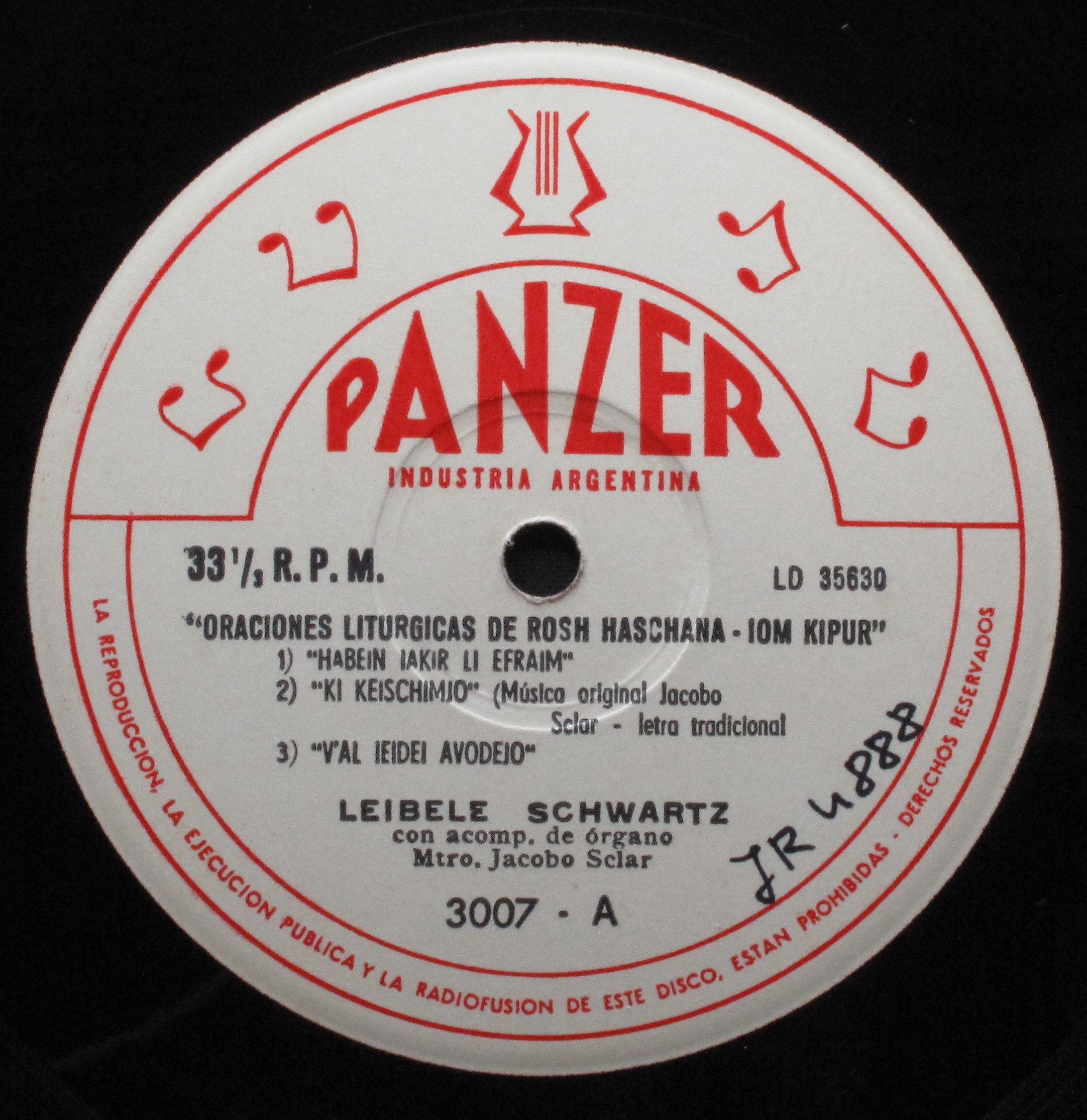
Leybele Schwartz, "Oraciones Liturgicas de Rosh Haschana- Yom Kipur" (Panzer Records)
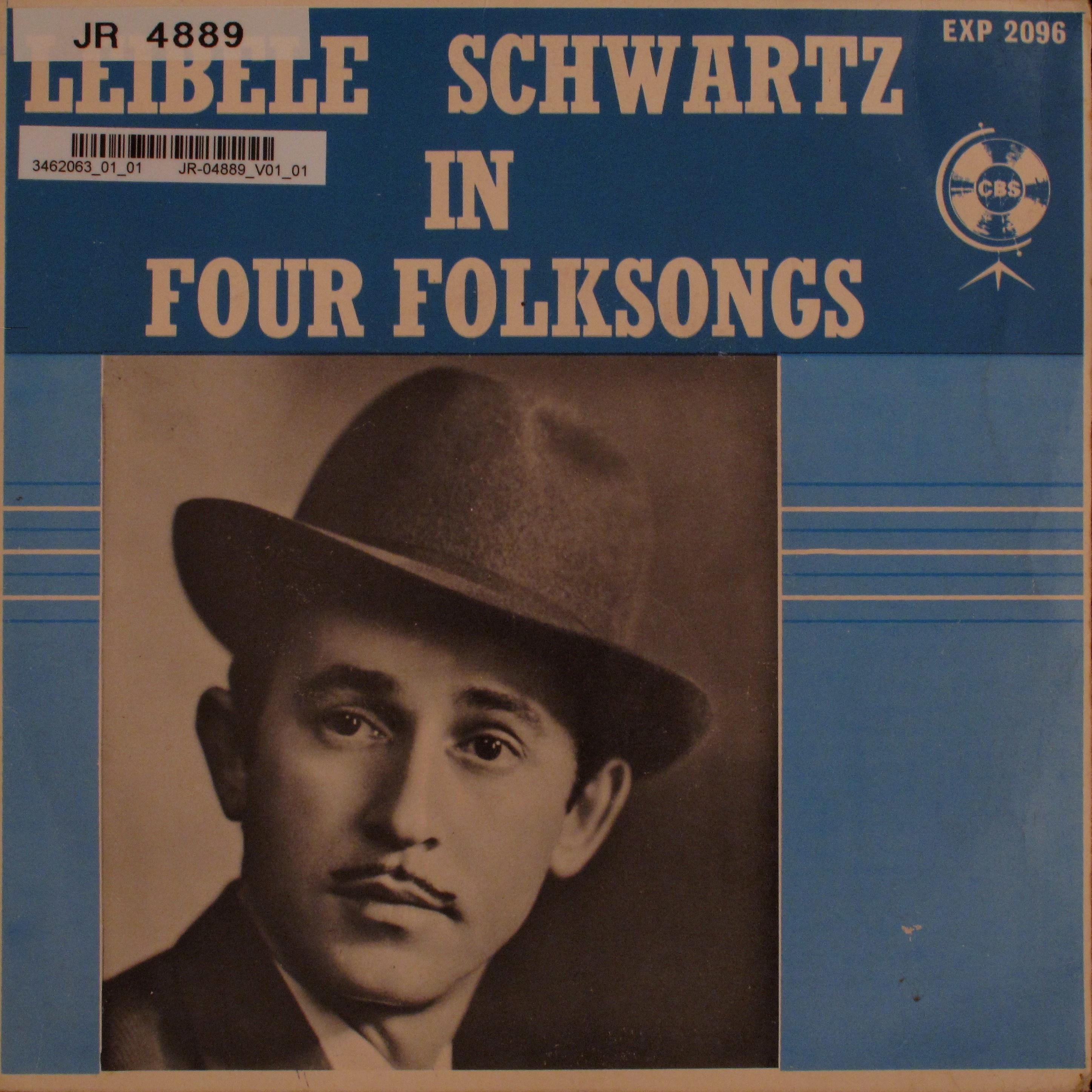
"Leibele Schwartz in four folksongs" (Sung in Yiddish)/ Leibele Schwartz, vocals; accompanied by Ken Espen (CBS)
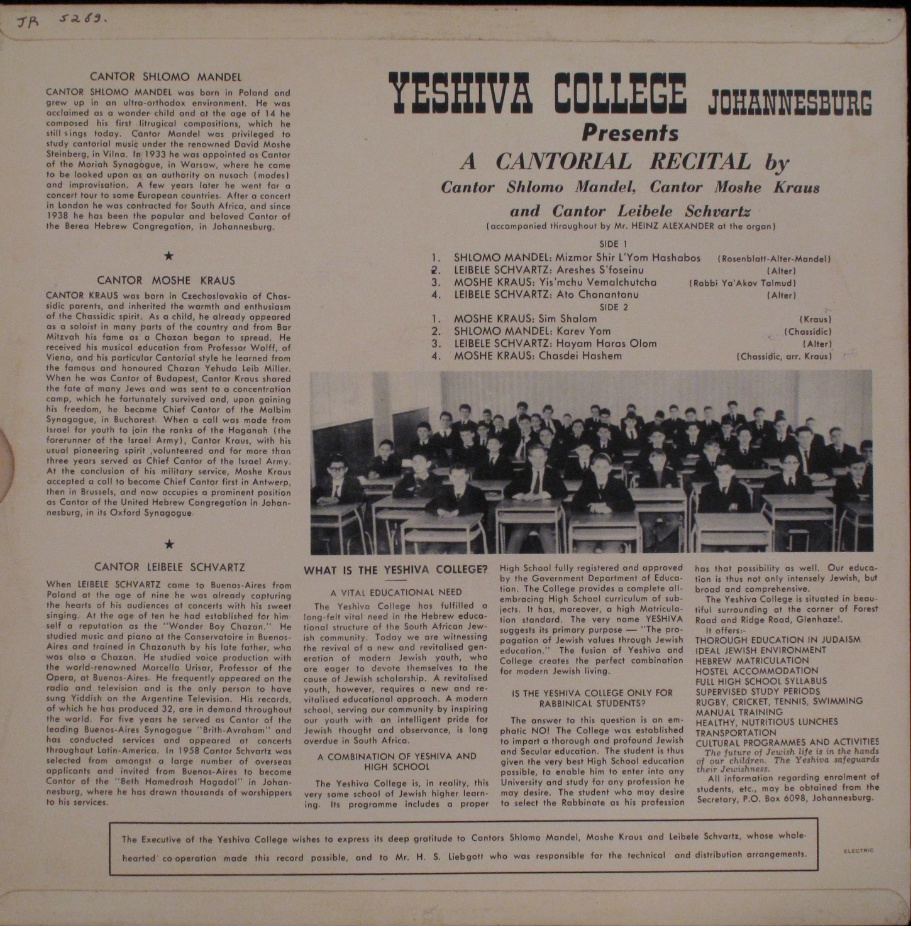
"Yeshiva College Johannesburg presents a cantorial recital by Cantor Shlomo Mandel, Cantor Moshe Kraus and Cantor Leibele Schvartz"
Commentary by Edwin Seroussi
The life of Léibele Schwartz exemplifies two issues in Jewish music research that deserve more attention. One is the Latin American scene in general, and the large Jewish populations of great metropolitan centers such as Buenos Aires in particular, that has only recently begun to attract attention, with emphasis on popular music, such as Jewish contributions to tango, and to a lesser extent the music of the Yiddish theatre. The scene of Jewish liturgical music in Latin America, on the other hand, has been rarely addressed.
The other issue is the spinning mobility at a global level of Jewish artists who, based in Latin America, toured they world moving back and forth from continent to continent, alternating between the synagogue, the Yiddish theatre stage and the recording studio. Yet, Jewish musicians such as Léibele Schwartz, most of them from Eastern Europe and trained as musicians there, have remained outside the main discourses of Jewish music research simply because their destiny led them to less hegemonic shores (from the point of view of academic and political power relations). Léibele’s liturgical repertoire shows his deep connection to the North American and European scenes of cantorial art during the “Golden Age.” He officiated in the most prestigious pulpits in three continents and appeared on the stage with all the luminaries of the Yiddish theatre before and after the Holocaust. For example, the voice of Léibele singing “Al harishunim” is included in such a prestigious international production as Cantors, klezmorim and crooners, 1905-1953 classic Yiddish 78s from the Mayrent collection. The work by Silvia Glocer and her contributions to the JMRC database contribute therefore to close this gap.



